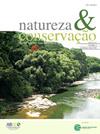Birds in agroscapes: effects of forest cover and landscape heterogeneity on dryland bird diversity and composition
IF 3.5
2区 环境科学与生态学
Q1 BIODIVERSITY CONSERVATION
引用次数: 0
Abstract
A research challenge for this century is the integration of highly productive and sustainable landscapes. This issue is crucial for semi-arid regions, where historical land management practices have led to habitat loss and desertification processes. In this study, we evaluated the relative effects of habitat amount (forest cover), landscape heterogeneity (landscape diversity) and spatial arrangement (forest fragmentation and edge density) on bird α and β-diversity in the Caatinga tropical dry forest of northeastern Brazil. We separately assessed the complete bird assemblage and three different ecological groups (forest specialist, habitat generalist and open-area specialist species). Our results indicate that habitat amount is the main positive driver of α and β-diversity of birds in the Caatinga landscapes. However, landscape heterogeneity emerged as an important positive driver for habitat generalist and open-area specialist species. Our results highlight the importance of landscape-scale forest cover and increasing landscape heterogeneity on productive lands as a strategy to balance food production and biodiversity conservation in dry forest regions such as the Caatinga.

农业景观中的鸟类:森林覆盖和景观异质性对旱地鸟类多样性和组成的影响
本世纪的一个研究挑战是高效和可持续景观的整合。这个问题对半干旱地区至关重要,在这些地区,历史上的土地管理做法导致了生境丧失和荒漠化进程。研究了巴西东北部Caatinga热带干旱林栖息地数量(森林覆盖)、景观异质性(景观多样性)和空间布局(森林破碎度和边缘密度)对鸟类α和β-多样性的相对影响。我们分别评估了完整的鸟类组合和3个不同的生态类群(森林特种鸟、生境特种鸟和开阔区特种鸟)。结果表明,生境数量是Caatinga景观中鸟类α和β-多样性的主要正向驱动因素。然而,景观异质性成为生境通才和开放区域专一物种的重要积极驱动因素。我们的研究结果强调了景观尺度森林覆盖和生产性土地景观异质性的重要性,作为平衡粮食生产和生物多样性保护的战略,如Caatinga干旱森林地区。
本文章由计算机程序翻译,如有差异,请以英文原文为准。
求助全文
约1分钟内获得全文
求助全文
来源期刊

Perspectives in Ecology and Conservation
Environmental Science-Nature and Landscape Conservation
CiteScore
7.80
自引率
4.30%
发文量
46
审稿时长
59 days
期刊介绍:
Perspectives in Ecology and Conservation (PECON) is a scientific journal devoted to improving theoretical and conceptual aspects of conservation science. It has the main purpose of communicating new research and advances to different actors of society, including researchers, conservationists, practitioners, and policymakers. Perspectives in Ecology and Conservation publishes original papers on biodiversity conservation and restoration, on the main drivers affecting native ecosystems, and on nature’s benefits to people and human wellbeing. This scope includes studies on biodiversity patterns, the effects of habitat loss, fragmentation, biological invasion and climate change on biodiversity, conservation genetics, spatial conservation planning, ecosystem management, ecosystem services, sustainability and resilience of socio-ecological systems, conservation policy, among others.
 求助内容:
求助内容: 应助结果提醒方式:
应助结果提醒方式:


